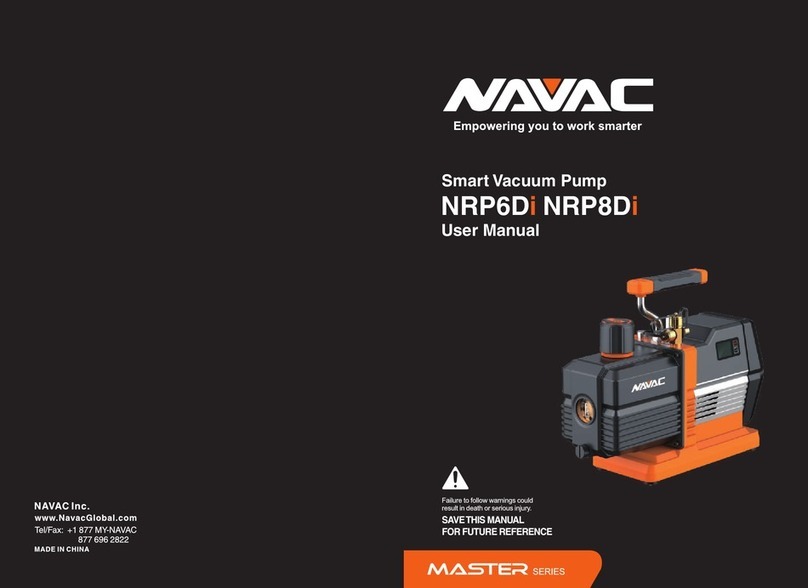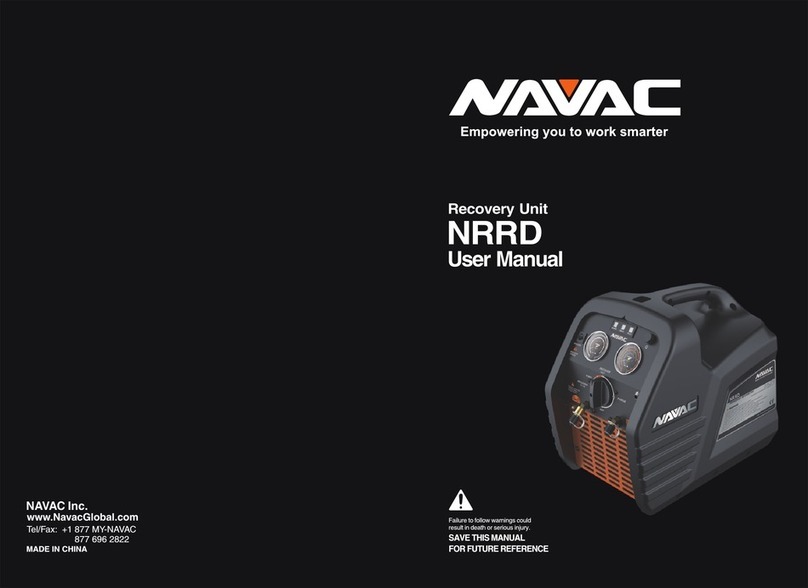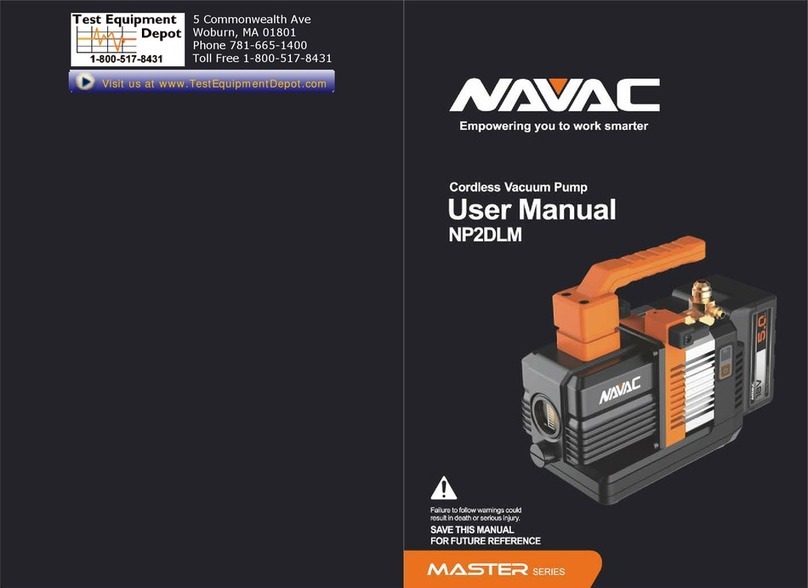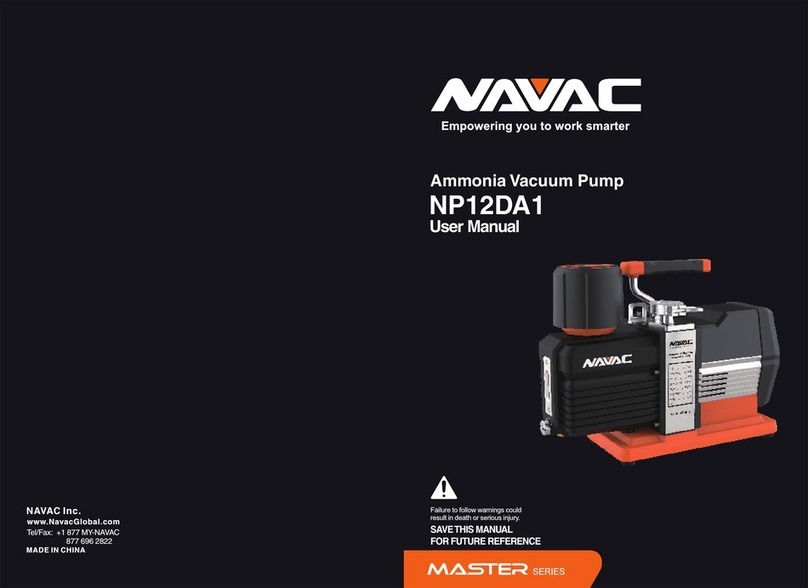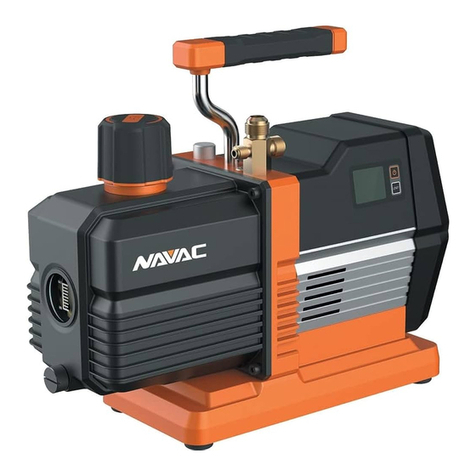
0504
MAINTENANCE
1. Vacuum pump oil has three major functions: pump lubricant, pump cooling, and pump sealant.
During the evacuation process, the pump oil will absorb moisture being pulled from the system,
causing it to be less effective as a lubricant and pump vane seal, extending evacuation time and
possibly allowing the pump to overheat. We recommend that the oil be changed just before
evacuating each A/C-R system to insure the pump oil is in a clean condition as this is the key factor
in determining if the pump can achieve the required vacuum levels. In order to maintain the
optimum operation of the pump, we recommend that you use NAVAC vacuum pump oil. This oil is
made using a unique process and can maintain proper viscosity during normal operation and
temperatures, and it’s also helpful for cold starts. Should the NAVAC oil not be available, reputable
brands of special-purpose vacuum pump oil may be used.
Note: Should the pump oil become opaque, dirty, or full of moisture, promptly change oil. This will
greatly speed up evacuation, especially when there is a lot of moisture in system piping from
having been left open to the atmosphere for an extended period of time.
Oil change procedure:
1. To ensure that the pump and oil are warm, run pump for approximately one minute prior to
changing oil. Do not run longer than this, as it may be possible to damage the pump.
2. While the pump is running, open one inlet port and allow oil to drain out of the pump. After turning
off pump, open the oil drain plug, and drain used oil into an appropriate vessel and dispose of
properly.
3. As oil stops draining, tip the pump to drain any remaining oil in the bottom of the pump.
4. Close oil drain valve.
5. Remove oil fill cap, pour in new oil until the oil is at the proper level in the sight glass (the same
procedure prior to using the pump above).
REQUIREMENTS FOR WARRANTY COVERAGE
Product warranty is provided for product quality problems for one years from date of sale. For
warranty to be valid, the following conditions must be met:
1. Products issues due to manufacturing defects confirmed by qualified agents.
2. Products which have not been maintained or dismantled by unauthorized parties.
3. Products that have been used in accordance with the User Manual. All maintenance services shall
be performed during the warranty period.
Statement: Other than repairing the product defective, the manufacturer of this product will not be
liable for any other costs, such as time spent in fixing the issue, refrigerant consumption,
refrigerant disposal costs, as well as unauthorized transportation and labor costs.
USE GUIDE
1. When using the vacuum pump, remove the inlet protection cap from the desired (1/4", 3/8", or 1/2")
connecting port, as shown in the diagram above, and connect the pump to the system or piping to be
evacuated. Use shortest hoses possible for faster and more thorough evacuation.
2. Inspect the hose inlet connection, as well as all connecting hoses for proper seal. There must be
no leakage or it will be impossible to draw the required deep vacuum level.
3. At the beginning of the evacuation process, open the GAS BALLAST, and once the vacuum
gauge reaches 2000 microns, retighten to achieve desired vacuum level.
4. After evacuation is completed, shut down the pump and close the system access valves.
5. Turn off the power switch on the pump and disconnect power.
6. Remove the evacuation hoses.
7. Close the air entry cap and the air exhaust cap tightly (with the exception of models without air
exhaust cap), to prevent dirt or particulates from entering the pump.
Note:
1. Always evacuate systems in conjunction with a micron vacuum gauge, such as the NAVAC
NMV1, giving you a comprehensive view of the sealed system internal evacuation condition.
2. Please pay attention to any changes in the oil level during pump operation. If the oil level falls
below the center line, immediately add more vacuum pump oil to avoid damage to the pump.
3. Vacuum pump and oil must be above 30℉.
1/4"
1/2"
3/8"
CAUTION
-To reduce the risk of electric shock, do not expose to rain.
Store indoors.
EXTENSION CORDS
If an extension cord must be used, be sure it is:
1. A 3-wire extension cord that has a 3-blade grounding plug, and a 3-slot receptacle that will accept
the plug on the product
2. In good condition
3. No longer than 50' (15.2m)
4. 16 gauge (AWG) or larger. (Wire size increases as gauge number decreases. 14 AWG and
12AWG may also be used. DO NOT USE 18 AWG )
NOTICE: Risk of Property Damage. The use of an undersized extension cord will cause voltage to
drop resulting in power loss to the motor and overheating.


















